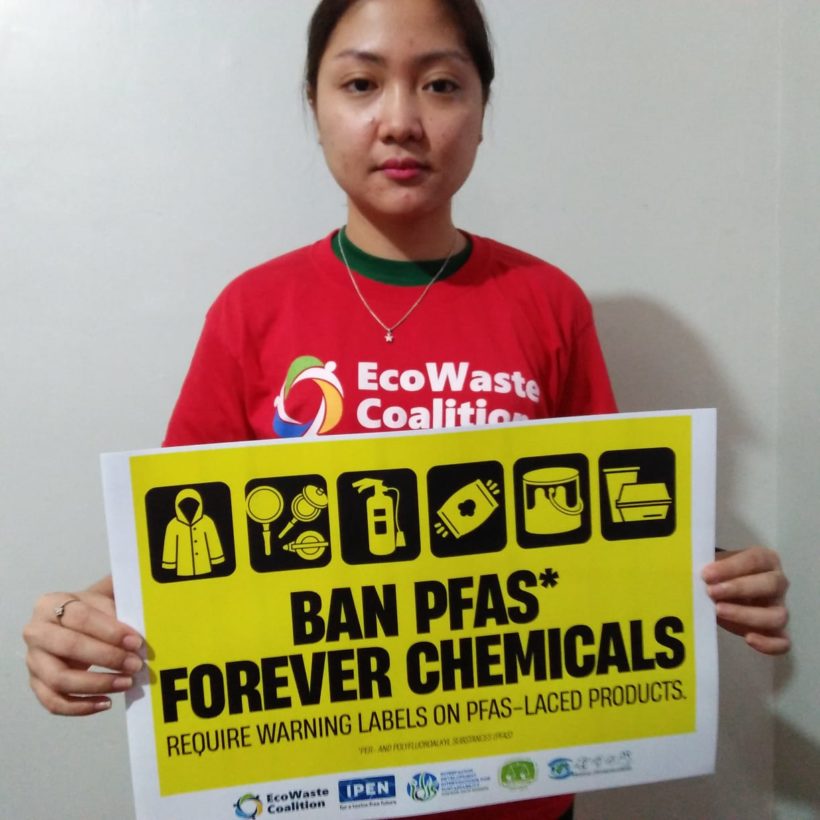1 June 2022, Quezon City. Various civil society groups have joined forces to call for a global ban on per- and polyfluoroalkyl substances (PFAS) ahead of World Environment Day. Also known as the “forever chemicals,” PFAS do not break down in the environment and build up in the bodies of humans and wildlife over time, resulting in adverse health effects.
At a webinar co-organized by the EcoWaste Coalition with the Consumers’ Association of Penang (CAP), Interfacing Development Interventions for Sustainability (IDIS), Taiwan Watch Institute (TWI) and the International Pollutants Elimination Network (IPEN), the groups pressed for a ban on PFAS as a class while conveying support for PFAS-free clothing, food packaging, cookware and other applications.
“To safeguard the health of workers, women and children, we propose that countries address PFAS chemicals as a class and ban them altogether. This will reduce the prospect of replacing one toxic type of PFAS with another,” the groups said. To date, perfluorooctanoic acid (PFOA) and perfluorooctane sulfonic acid (PFOS) have been listed as persistent organic pollutants (POPs) targeted for a global ban under the Stockholm Convention, while perfluorohexane sulfonic acid (PFHxS) has been recommended as candidate POP for consideration by the 10th Conference of the Parties (COP10) of the Convention this June 2022.
“In the interim, we urge governments to require manufacturers to disclose PFAS content in products, especially in products that may contribute to PFAS exposure among women of childbearing age, and to provide clear warning labels in keeping with the consumer right to know and be protected against hazardous substances in products,” the groups insisted.
The groups’ push for a global phase-out of PFAS and for mandatory PFAS labeling was reinforced by the findings of a pioneering study on endocrine-disrupting chemicals (EDCs) led by Dr. Michael Velarde of the University of the Philippines (UP) Institute of Biology indicating elevated levels of PFAS in women with breast cancer in the Greater Manila Area.
“Breast cancer is now the most common form of cancer globally, with the Philippines having the highest mortality due to breast cancer in Asia. A majority of breast cancer cases occur in women with undetermined risk factors, including exposure to endocrine-disrupting chemicals such as PFAS. Indeed, we observed a higher amount of PFAS in women with breast cancer versus non-cancer individuals.” said Velarde. “As PFAS are found in non-stick cookware, furniture, food packaging, wrappers and other PFAS-treated products and materials, we hope that the data generated will prompt the authorities to look into the PFAS situation in our country and to take on essential measures, including banning PFAS, especially in everyday products.”
As presented at the webinar, the said study generated data on the exposure of Filipino women to 41 EDCs, including 12 types of PFAS, 11 phthalates, 10 bisphenols and 8 phenols. After analyzing blood samples from women with versus without breast cancer, the study was able to establish that PFAS were significantly associated with breast cancer.
The study found long-chain PFAS were considerably higher in women from Region IV-A, or Calabarzon, the country’s “industrial powerhouse,” compared to the National Capital Region. It also found levels of PFOSA (a type of PFAS) significantly higher among factory workers compared to non-factory workers. It likewise found PFDoA (another type of PFAS) to be elevated among household workers compared to non-household workers.
PFAS are manufactured chemicals known for their grease- and water-resistant properties. PFAS are often used in grease-proof food wrappers, non-stick cookware, water repellant apparel, stain-resistant carpets and upholstery, firefighting foams, paints, coatings and sealants, polishes and waxes, and even in cosmetics.
Humans are exposed to PFAS by drinking PFAS-contaminated water, eating food crops grown on PFAS-contaminated soil, cooked in PFAS-laden cookware or packaged in PFAS-containing disposable packaging material, consuming fish caught from PFAS-contaminated water, inhaling air and dust particles polluted with PFAS, and skin absorption from cleaning and cosmetic products containing PFAS.
According to the US Agency for Toxic Substances and Disease Registry (ATSDR), PFAS exposure may lead to “increased cholesterol levels, changes in liver enzymes, small decreases in infant birth weights, decrease vaccine response in children, increased risk of high blood pressure or pre-eclampsia in pregnant women, and increased risk of kidney or testicular cancer.”
To prevent exposure to PFAS, especially in the household setting, the groups urge the public to:
— Avoid non-stick pans and kitchen utensils, and use stainless steel or cast iron instead.
— Be wary of fabrics labeled stain- or water-repellant.
— Minimize greasy fast foods—these foods often come in PFAS-treated containers.
— Avoid microwaveable popcorn and popcorn the old-fashioned way—on the stovetop.
— Choose personal care products without “PTFE” or “fluoro” ingredients.
– Find products that haven’t been pre-treated and skip optional stain-repellant treatments on new carpets and furniture.
References:
https://pubmed.ncbi.nlm.nih.gov/34293563/
https://www.atsdr.cdc.gov/pfas/health-effects/index.html
http://www.pops.int/TheConvention/ThePOPs/TheNewPOPs/tabid/2511/Default.aspx
http://chm.pops.int/theconvention/thepops/chemicalsproposedforlisting/tabid/2510/default.aspx






